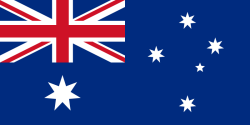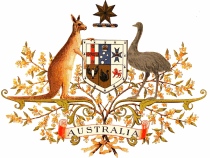Commonwealth of Australia
Related Categories:
 Flag of Australia
Flag of AustraliaBlue with the flag of the UK in the upper hoist-side quadrant and a large seven-pointed star in the lower hoist-side quadrant known as the Commonwealth or Federation Star, representing the federation of the colonies of Australia in 1901; the star depicts one point for each of the six original states and one representing all of Australia's internal and external territories; on the fly half is a representation of the Southern Cross constellation in white with one small five-pointed star and four larger, seven-pointed stars. |

 Australian Coat of Arms
Australian Coat of Arms |
Australian Symbols - Colours, Coat of Arms, Floral Emblems, Flag. Australian free information service - from Australian animals to culture and more.
alldownunder.com/
Design of the flag, History of the flag, Red Ensign (Merchant Ensign), Construction Details, Centenary Flag (official "flag of state"), Special Flag Flying Days.
www.fotw.us/
The name "Australia" is derived from the Latin Australis, meaning of the South. Legends of an "unknown land of the south" (terra australis incognita) dating back to Roman times were commonplace in mediŠval geography, but they were not based on any actual knowledge of the continent.
en.wikipedia.org/
Australia's aboriginal inhabitants, a hunting-gathering people generally referred to as Aboriginals and Torres Straits Islanders, arrived more than 40,000 years ago. Although their technical culture remained static--depending on wood, bone, and stone tools and weapons--their spiritual and social life was highly complex. Most spoke several languages, and confederacies sometimes linked widely scattered tribal groups. Aboriginal population density ranged from one person per square mile along the coasts to one person per 35 square miles in the arid interior. When Capt. James Cook claimed Australia for Great Britain in 1770, the native population may have numbered 300,000 in as many as 500 tribes speaking many different languages. The aboriginal population currently numbers more than 410,000, representing about 2.2% of the population. Since the end of World War II, the government and the public have made efforts to be more responsive to aboriginal rights and needs.
Immigration has been a key to Australia's development since the beginning of European settlement in 1788. For generations, most settlers came from the British Isles, and the people of Australia are still predominantly of British or Irish origin, with a culture and outlook similar to those of Americans. However, since the end of World War II, the population has more than doubled; non-European immigration, mostly from the Middle East, Asia, and Latin America, has increased significantly since 1960 through an extensive, planned immigration program. From 1945 through 2000, nearly 5.9 million immigrants settled in Australia, and about 80% have remained; nearly two of every seven Australians is foreign-born. Britain and Ireland have been the largest sources of post-war immigrants, followed by Italy, Greece, New Zealand, and the former Yugoslavia.
Australia's humanitarian and refugee admissions of about 12,000 per year are in addition to the normal immigration program. In recent years, refugees from Africa, the Middle East, and Southwest Asia have comprised the largest element in Australia's refugee program.
Although Australia has scarcely more than two people per square kilometer, it is one of the world's most urbanized countries. Less than 15% of the population lives in rural areas.
www.state.gov/r/
Introduction
About
Contact
Symbols in The News
Interpret this Symbol
AAC
African
AI
Alchemy
Alphabets
Ancient
Animal Symbolism
Architecture
Art
Articles
Astrology
Baha'i
Blissymbolics
Blueprint Symbols
Buddhist
Celtic Symbols
Cemetery
Chinese Symbols
Christian
Circle
City
Codes
Color
Conlangs
Crop Circles
Danger
Da Vinci Code
Designing Logos
Dictionaries
Dreams
Education
Egyptian Symbols
Electrical
Emoticons
Find Images
Fonts
Food
Fraternity
Hamsa
Healing
Heraldry
Hermetic
Highway Signs
Hindu
History
Hobo
Holiday
Icons
iConji
Islamic
Jain Symbols
Japanese, Kanji
Jewish
Justice
Law
Literary Symbolism
Mandalas
Map
Masonic
Math, Number
Meaning of Names
Medical
Middle East
Military
Miscellaneous
Money
Music
Mythology
Native American
Playing Cards
Power
Psychology
QiQiiKhu
Reiki
Religious
Runes, Norse
Sacred Geometry
Scientific
Science Fiction
Sorority
Sports
Symbols in the News
Tattoos
ThirteenSymbols
Tree of Life
Ursprache
Videos
Visual Languages
Weather
Web Codes
Wicca
Words
Writing Systems
Braille
Coinherence
Coptic
Cuneiform
Easter Island
Etruscan
Happy Human
Hebrew
Kokopelli
Linear B
Lotus
Love Symbols
Mandorla
Moon Alphabet
Nine Pointed Star
Om
Oz
Phonetic
Scarab Beetle
Silent
Theosophy
Unifon
About
Contact
Symbols in The News
Interpret this Symbol
AAC
African
AI
Alchemy
Alphabets
Ancient
Animal Symbolism
Architecture
Art
Articles
Astrology
Baha'i
Blissymbolics
Blueprint Symbols
Buddhist
Celtic Symbols
Cemetery
Chinese Symbols
Christian
Circle
City
Codes
Color
Conlangs
Crop Circles
Danger
Da Vinci Code
Designing Logos
Dictionaries
Dreams
Education
Egyptian Symbols
Electrical
Emoticons
Find Images
Fonts
Food
Fraternity
Hamsa
Healing
Heraldry
Hermetic
Highway Signs
Hindu
History
Hobo
Holiday
Icons
iConji
Islamic
Jain Symbols
Japanese, Kanji
Jewish
Justice
Law
Literary Symbolism
Mandalas
Map
Masonic
Math, Number
Meaning of Names
Medical
Middle East
Military
Miscellaneous
Money
Music
Mythology
Native American
Playing Cards
Power
Psychology
QiQiiKhu
Reiki
Religious
Runes, Norse
Sacred Geometry
Scientific
Science Fiction
Sorority
Sports
Symbols in the News
Tattoos
ThirteenSymbols
Tree of Life
Ursprache
Videos
Visual Languages
Weather
Web Codes
Wicca
Words
Writing Systems
Braille
Coinherence
Coptic
Cuneiform
Easter Island
Etruscan
Happy Human
Hebrew
Kokopelli
Linear B
Lotus
Love Symbols
Mandorla
Moon Alphabet
Nine Pointed Star
Om
Oz
Phonetic
Scarab Beetle
Silent
Theosophy
Unifon
